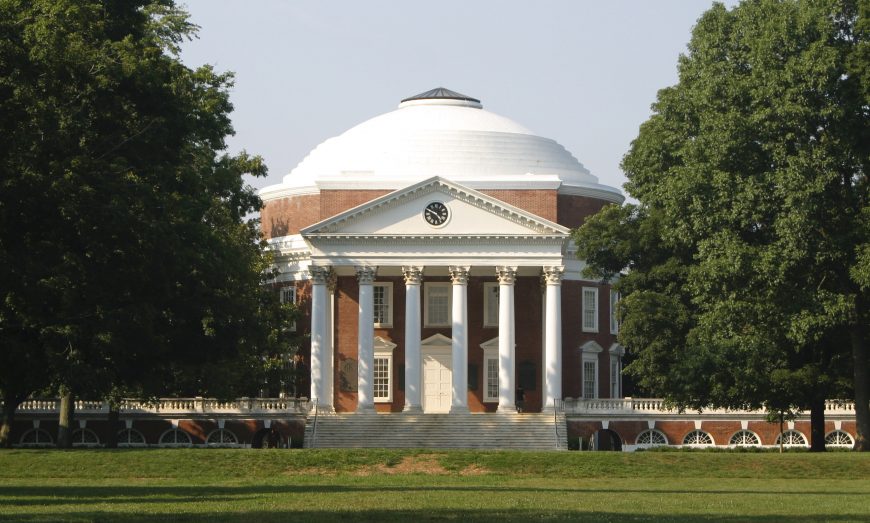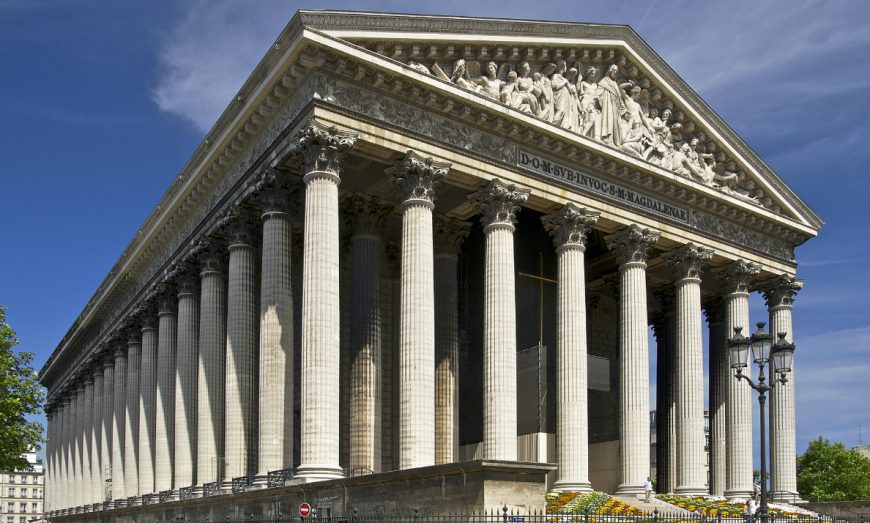A conversation with Dr. Steven Zucker and Dr. Beth Harris in front of HBRA Architects, United States Federal Building and Courthouse, 2011, Tuscaloosa, Alabama
[0:00] [music]
Dr. Steven Zucker: [0:04] We’re in Tuscaloosa, Alabama, standing in front of the United States Federal Building and Courthouse. This is a building that is not very old, but it references an architecture that comes from two millennia ago.
Dr. Beth Harris: [0:16] This building looks like an ancient Greek temple, specifically a Doric temple.
Dr. Zucker: [0:22] The Doric is easily recognized through the massive columns with simple capitals and with no base.
Dr. Harris: [0:28] Those Doric columns carry a frieze, and then above that, this triangular shape called a pediment, and then above [that] on the roofline decorative forms called acroteria.
[0:41] We’re talking specifically about the main entrance, but there are wings on either side. This is a building that has to house modern offices for the federal government.
Dr. Zucker: [0:51] This building is remarkably faithful to the ancient Greek tradition.
Dr. Harris: [0:54] This style was revived in the 18th century at the time of the founding of the United States. We associate this style with so many government buildings like the White House and Congress and [the] Supreme Court building. In a way, this style has come to represent ideals of democracy, of civic virtue.
Dr. Zucker: [1:16] It’s worth taking a moment to think about what the ancient Greek architectural vocabulary meant in the early years of the United States. The 18th and 19th centuries were a time of architectural revival.
[1:27] It’s almost as if European and American culture looked back to history as a place that they could pilfer from, that they could borrow from, and so you have Neo-Egyptian, you have an important revival of the Gothic, but the neoclassical had special significance.
[1:43] The architect-planner L’Enfant, who’s credited with planning Washington, D.C., the federal city, was looking back to ancient Greece because he understood Athens to be the birthplace of democracy.
Dr. Harris: [1:54] The problem, I think, comes in in the idea of mandating from the federal government and imposing one style on a country which is very large and very heterogeneous, and also the associations of classical architecture to white European values.
Dr. Zucker: [2:12] And to the exclusion of all other types of cultural heritage.
Dr. Harris: [2:16] And an assertion that this style is superior.
Dr. Zucker: [2:19] In December of 2020, when President Trump issued an executive order mandating that federal buildings must be in a neoclassical style, using a vocabulary that struck many historians as uncomfortably close to the kind of rhetoric that was used by totalitarian regimes.
Dr. Harris: [2:36] For example, we could look back at the example of Nazi Germany and their attack on modern art and their promotion of classical art. The ramifications were very dangerous and often lethal.
Dr. Zucker: [2:49] Artists were persecuted, some artists were sent to death camps. Their artwork was destroyed and only certain kinds of art could be made, and so many people noticed this very uncomfortable parallel, but I think we have to be careful. We don’t want to vilify the neoclassical. The neoclassical can be beautiful, but it is not the only kind of beauty.
Dr. Harris: [3:08] There’s an argument to be made. There is the idea that this is a kind of civic architecture that has a long history in the United States, that’s associated with government functions, with high civic ideals, and this is a beautiful building, and when one approaches it, one has a sense of grandeur, of monumentality, and those civic virtues that we associate with neoclassical architecture.
Dr. Zucker: [3:34] We chose to have this discussion in front of this particular building because the executive order singles it out as one of the great examples that architecture should now be.
Dr. Harris: [3:46] And just recently, President Biden rescinded Trump’s executive order. So while it might seem like we’re just talking about architectural styles, we’re really talking about something that is deeply important in the social life of our country.
[4:01] [music]






